cylinder SUZUKI SX4 2006 1.G Service Workshop Manual
[x] Cancel search | Manufacturer: SUZUKI, Model Year: 2006, Model line: SX4, Model: SUZUKI SX4 2006 1.GPages: 1556, PDF Size: 37.31 MB
Page 583 of 1556

Downloaded from www.Manualslib.com manuals search engine Brake Control System and Diagnosis: 4A-12
3) Drain brake fluid in reservoir.
4) Disconnect clutch reservoir hose from reservoir (M/T
model).
5) Remove reservoir connector pin (1) by using special
tool and then reservoir.
Special tool
(A): 09916–44310
Installation
1) When using new grommets (2), lubricate them with
the same fluid as the one to fill reservoir with.
Then press-fit grommets (2) to master cylinder (3).
2) Install reservoir (1) to master cylinder.
3) Drive in reservoir connector pin (2) by using special
tool (A). Till both of its ends at the right and left of
reservoir (1) becomes the same length.
Special tool
(A): 09916–44310 4) Connect clutch reservoir hose to reservoir (M/T
model).
5) Connect fluid level switch coupler (1) and clamp (3)
to reservoir (2).
6) Fill reservoir with specified brake fluid up to its MAX
level.
7) After completing the work, bleed air from brake
system referring to “Air Bleeding of Brake System”
and bleed air from clutch system referring to“Air
Bleeding of Clutch System in Section 5C” (M/T
model).
8) Check each installed parts for fluid leakage.
9) Perform brake test and check fluid leakage.
Master Cylinder Removal and InstallationS6RW0D4106012
Removal
CAUTION!
• Never disassemble master cylinder since
the master cylinder is supplied as
assembly parts.
If faulty condition is found, replace it with
new one.
• Do not allow brake fluid to get on painted
surfaces. Painted surfaces will be
damaged by brake fluid, flush it with water
immediately if any fluid is spilled.
1) Clean outside of master cylinder.
2) Disconnect fluid level switch coupler (1) and clamp
(3) from reservoir (2).
1 (A)I5JB0A410013-02
1
2
2
3
I7RW01410010-02
I7RW01410011-01
2
13
I7RW01410009-01
2
13
I7RW01410009-01
Page 584 of 1556
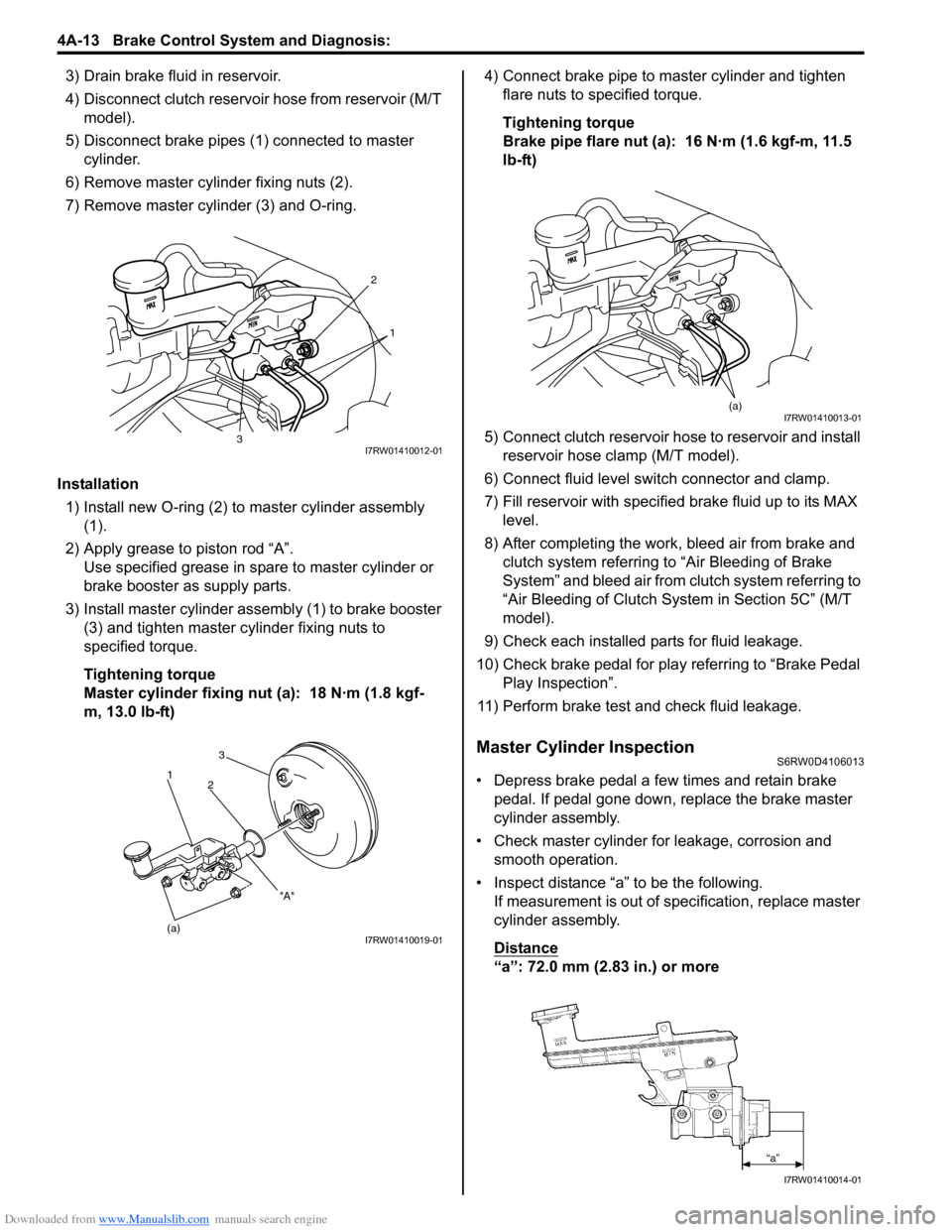
Downloaded from www.Manualslib.com manuals search engine 4A-13 Brake Control System and Diagnosis:
3) Drain brake fluid in reservoir.
4) Disconnect clutch reservoir hose from reservoir (M/T
model).
5) Disconnect brake pipes (1) connected to master
cylinder.
6) Remove master cylinder fixing nuts (2).
7) Remove master cylinder (3) and O-ring.
Installation
1) Install new O-ring (2) to master cylinder assembly
(1).
2) Apply grease to piston rod “A”.
Use specified grease in spare to master cylinder or
brake booster as supply parts.
3) Install master cylinder assembly (1) to brake booster
(3) and tighten master cylinder fixing nuts to
specified torque.
Tightening torque
Master cylinder fixing nut (a): 18 N·m (1.8 kgf-
m, 13.0 lb-ft)4) Connect brake pipe to master cylinder and tighten
flare nuts to specified torque.
Tightening torque
Brake pipe flare nut (a): 16 N·m (1.6 kgf-m, 11.5
lb-ft)
5) Connect clutch reservoir hose to reservoir and install
reservoir hose clamp (M/T model).
6) Connect fluid level switch connector and clamp.
7) Fill reservoir with specified brake fluid up to its MAX
level.
8) After completing the work, bleed air from brake and
clutch system referring to “Air Bleeding of Brake
System” and bleed air from clutch system referring to
“Air Bleeding of Clutch System in Section 5C” (M/T
model).
9) Check each installed parts for fluid leakage.
10) Check brake pedal for play referring to “Brake Pedal
Play Inspection”.
11) Perform brake test and check fluid leakage.
Master Cylinder InspectionS6RW0D4106013
• Depress brake pedal a few times and retain brake
pedal. If pedal gone down, replace the brake master
cylinder assembly.
• Check master cylinder for leakage, corrosion and
smooth operation.
• Inspect distance “a” to be the following.
If measurement is out of specification, replace master
cylinder assembly.
Distance
“a”: 72.0 mm (2.83 in.) or more
2
1
3I7RW01410012-01
(a)3
2
1
"A"
I7RW01410019-01
(a)I7RW01410013-01
I7RW01410014-01
Page 586 of 1556
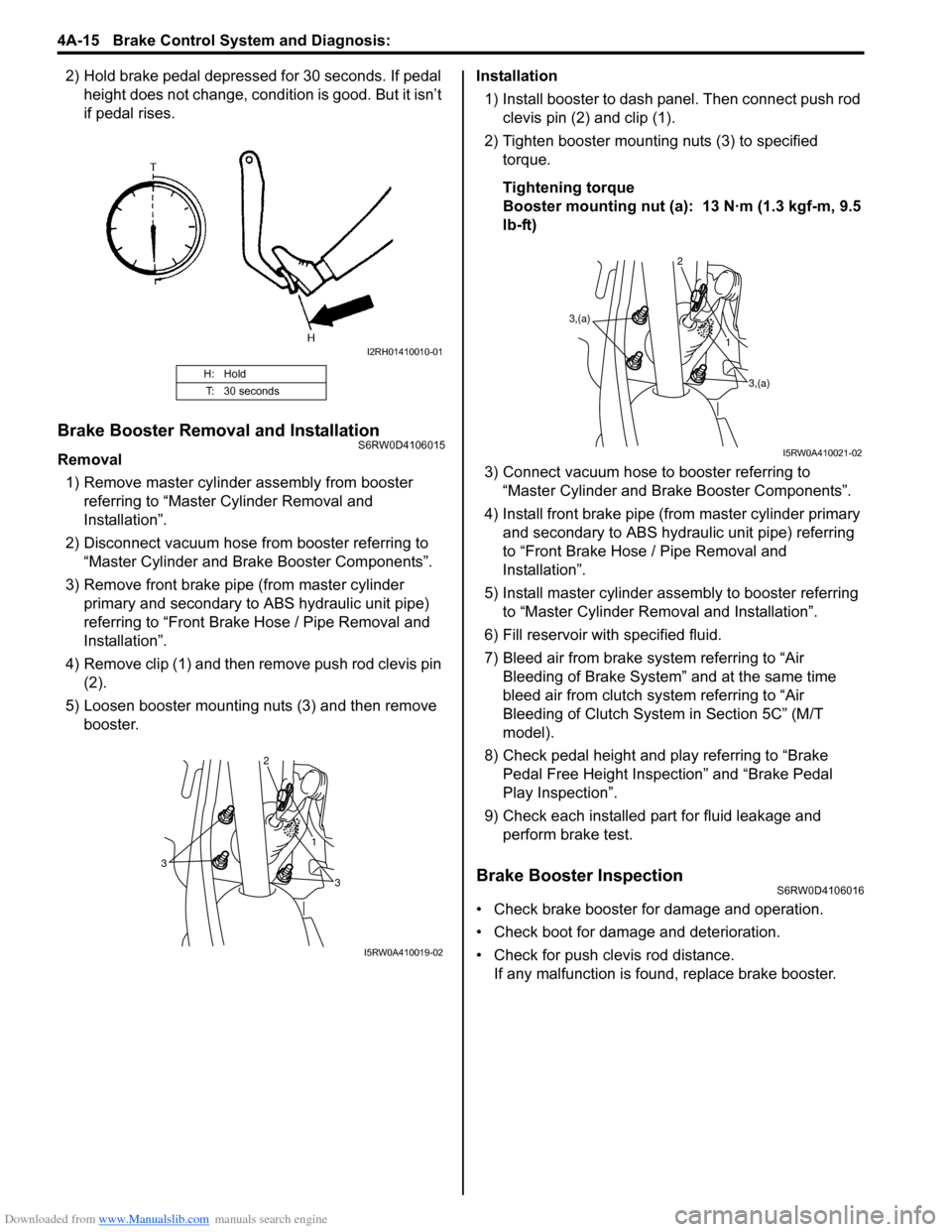
Downloaded from www.Manualslib.com manuals search engine 4A-15 Brake Control System and Diagnosis:
2) Hold brake pedal depressed for 30 seconds. If pedal
height does not change, condition is good. But it isn’t
if pedal rises.
Brake Booster Removal and InstallationS6RW0D4106015
Removal
1) Remove master cylinder assembly from booster
referring to “Master Cylinder Removal and
Installation”.
2) Disconnect vacuum hose from booster referring to
“Master Cylinder and Brake Booster Components”.
3) Remove front brake pipe (from master cylinder
primary and secondary to ABS hydraulic unit pipe)
referring to “Front Brake Hose / Pipe Removal and
Installation”.
4) Remove clip (1) and then remove push rod clevis pin
(2).
5) Loosen booster mounting nuts (3) and then remove
booster.Installation
1) Install booster to dash panel. Then connect push rod
clevis pin (2) and clip (1).
2) Tighten booster mounting nuts (3) to specified
torque.
Tightening torque
Booster mounting nut (a): 13 N·m (1.3 kgf-m, 9.5
lb-ft)
3) Connect vacuum hose to booster referring to
“Master Cylinder and Brake Booster Components”.
4) Install front brake pipe (from master cylinder primary
and secondary to ABS hydraulic unit pipe) referring
to “Front Brake Hose / Pipe Removal and
Installation”.
5) Install master cylinder assembly to booster referring
to “Master Cylinder Removal and Installation”.
6) Fill reservoir with specified fluid.
7) Bleed air from brake system referring to “Air
Bleeding of Brake System” and at the same time
bleed air from clutch system referring to “Air
Bleeding of Clutch System in Section 5C” (M/T
model).
8) Check pedal height and play referring to “Brake
Pedal Free Height Inspection” and “Brake Pedal
Play Inspection”.
9) Check each installed part for fluid leakage and
perform brake test.
Brake Booster InspectionS6RW0D4106016
• Check brake booster for damage and operation.
• Check boot for damage and deterioration.
• Check for push clevis rod distance.
If any malfunction is found, replace brake booster.
H: Hold
T: 30 seconds
I2RH01410010-01
3
3 1 2
I5RW0A410019-02
3,(a)
3,(a) 1 2
I5RW0A410021-02
Page 587 of 1556
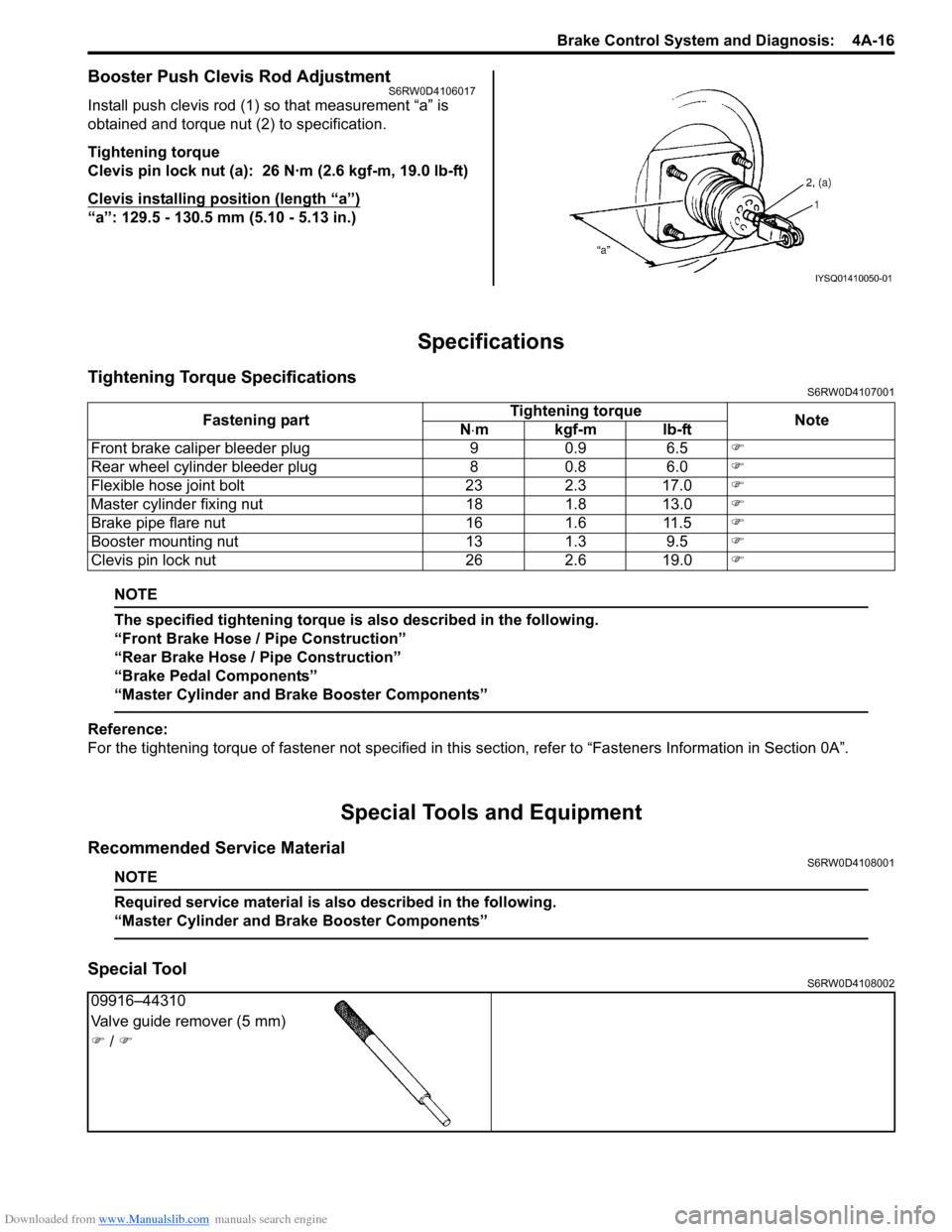
Downloaded from www.Manualslib.com manuals search engine Brake Control System and Diagnosis: 4A-16
Booster Push Clevis Rod AdjustmentS6RW0D4106017
Install push clevis rod (1) so that measurement “a” is
obtained and torque nut (2) to specification.
Tightening torque
Clevis pin lock nut (a): 26 N·m (2.6 kgf-m, 19.0 lb-ft)
Clevis installing position (length “a”)
“a”: 129.5 - 130.5 mm (5.10 - 5.13 in.)
Specifications
Tightening Torque SpecificationsS6RW0D4107001
NOTE
The specified tightening torque is also described in the following.
“Front Brake Hose / Pipe Construction”
“Rear Brake Hose / Pipe Construction”
“Brake Pedal Components”
“Master Cylinder and Brake Booster Components”
Reference:
For the tightening torque of fastener not specified in this section, refer to “Fasteners Information in Section 0A”.
Special Tools and Equipment
Recommended Service MaterialS6RW0D4108001
NOTE
Required service material is also described in the following.
“Master Cylinder and Brake Booster Components”
Special ToolS6RW0D4108002
IYSQ01410050-01
Fastening partTightening torque
Note
N⋅mkgf-mlb-ft
Front brake caliper bleeder plug 9 0.9 6.5�)
Rear wheel cylinder bleeder plug 8 0.8 6.0�)
Flexible hose joint bolt 23 2.3 17.0�)
Master cylinder fixing nut 18 1.8 13.0�)
Brake pipe flare nut 16 1.6 11.5�)
Booster mounting nut 13 1.3 9.5�)
Clevis pin lock nut 26 2.6 19.0�)
09916–44310
Valve guide remover (5 mm)
�) / �)
Page 588 of 1556
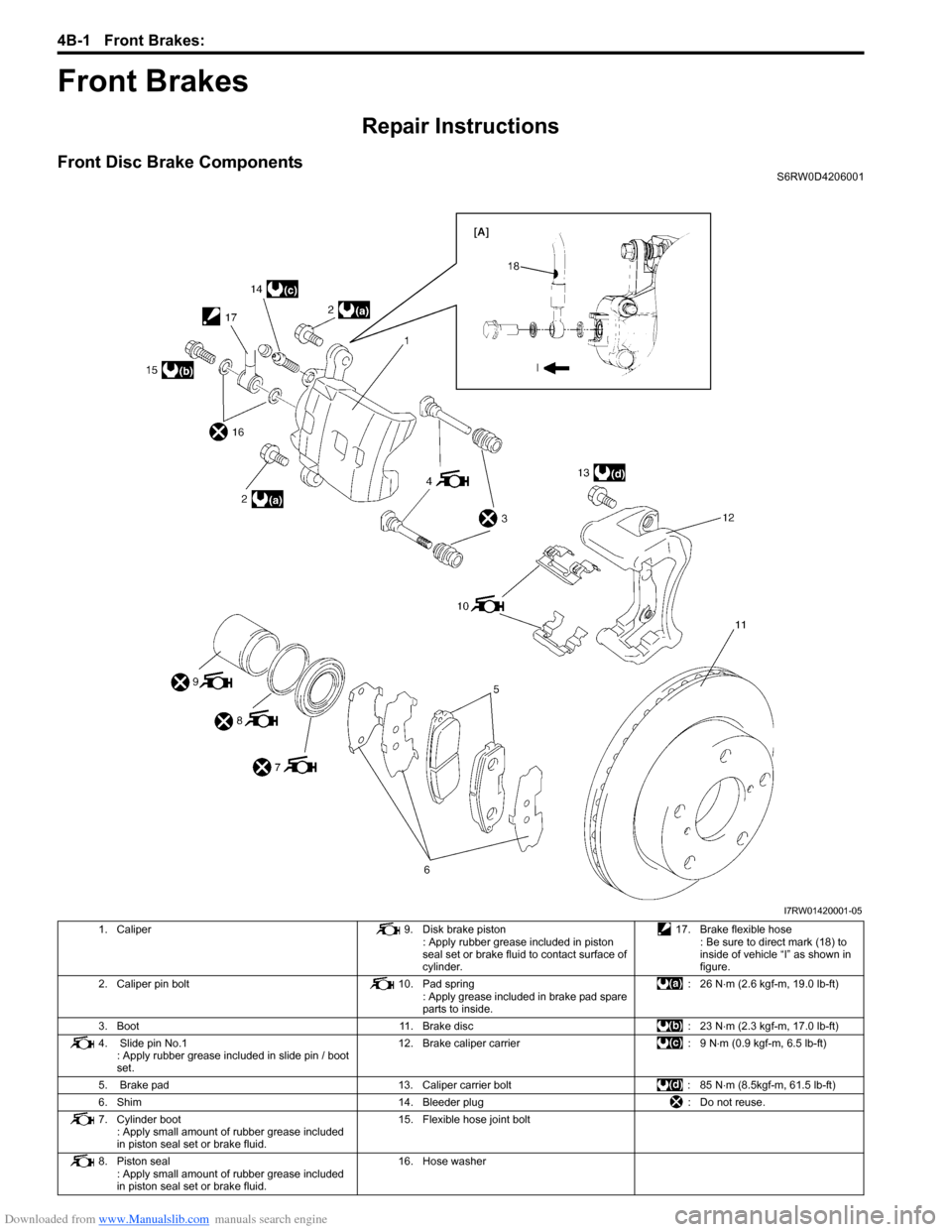
Downloaded from www.Manualslib.com manuals search engine 4B-1 Front Brakes:
Brakes
Front Brakes
Repair Instructions
Front Disc Brake ComponentsS6RW0D4206001
I7RW01420001-05
1. Caliper 9. Disk brake piston
: Apply rubber grease included in piston
seal set or brake fluid to contact surface of
cylinder.17. Brake flexible hose
: Be sure to direct mark (18) to
inside of vehicle “I” as shown in
figure.
2. Caliper pin bolt 10. Pad spring
: Apply grease included in brake pad spare
parts to inside.: 26 N⋅m (2.6 kgf-m, 19.0 lb-ft)
3. Boot 11. Brake disc : 23 N⋅m (2.3 kgf-m, 17.0 lb-ft)
4. Slide pin No.1
: Apply rubber grease included in slide pin / boot
set.12. Brake caliper carrier : 9 N⋅m (0.9 kgf-m, 6.5 lb-ft)
5. Brake pad 13. Caliper carrier bolt : 85 N⋅m (8.5kgf-m, 61.5 lb-ft)
6. Shim 14. Bleeder plug : Do not reuse.
7. Cylinder boot
: Apply small amount of rubber grease included
in piston seal set or brake fluid.15. Flexible hose joint bolt
8. Piston seal
: Apply small amount of rubber grease included
in piston seal set or brake fluid.16. Hose washer
Page 591 of 1556

Downloaded from www.Manualslib.com manuals search engine Front Brakes: 4B-4
3) Connect flexible hose (3) to caliper as shown in
figure.
4) Torque flexible hose joint bolt to specification.
Tightening torque
Flexible hose joint bolt (a): 23 N·m (2.3 kgf-m,
17.0 lb-ft)
WARNING!
• Make sure that flexible hose is not twisted
when tightening joint bolt. If it is twisted,
reconnect it using care not to twist it.
• Be sure to direct mark (1) to inside of
vehicle (2) as shown in figure.
5) Tighten bleeder plug to specified torque.
Tightening torque
Bleeder plug (b): 9 N·m (0.9 kgf-m, 6.5 lb-ft)
6) Install front wheel referring to “Wheel (with Tire)
Removal and Installation in Section 2D”.
7) After completing the installation, fill reservoir with
brake fluid and bleed air from brake system referring
to “Air Bleeding of Brake System in Section 4A”.
8) Check every installed part for fluid leakage.
9) Perform brake test and check fluid leakage.
Front Disc Brake Caliper Disassembly and
Assembly
S6RW0D4206006
Disassembly
CAUTION!
Clean around caliper with brake fluid before
disassembly.
1) Remove disc brake piston with air blown into flexible
hose joint bolt installation hole.
WARNING!
Do not apply too highly compressed air
which will cause piston to jump out of
cylinder. Place a cloth (1) to prevent piston
from damage. It should be taken out
gradually with moderately compressed air.
Do not place your fingers in front of piston
when using compressed air.
2) Remove cylinder boot.
3) Remove piston seal using a thin blade like a
thickness gauge, etc.
CAUTION!
Be careful not to damage inside (bore side) of
cylinder.
4) Remove bleeder plug and cap from caliper.
I7RW01420007-02
I2RH01420011-01
I2RH01420013-01
Page 592 of 1556
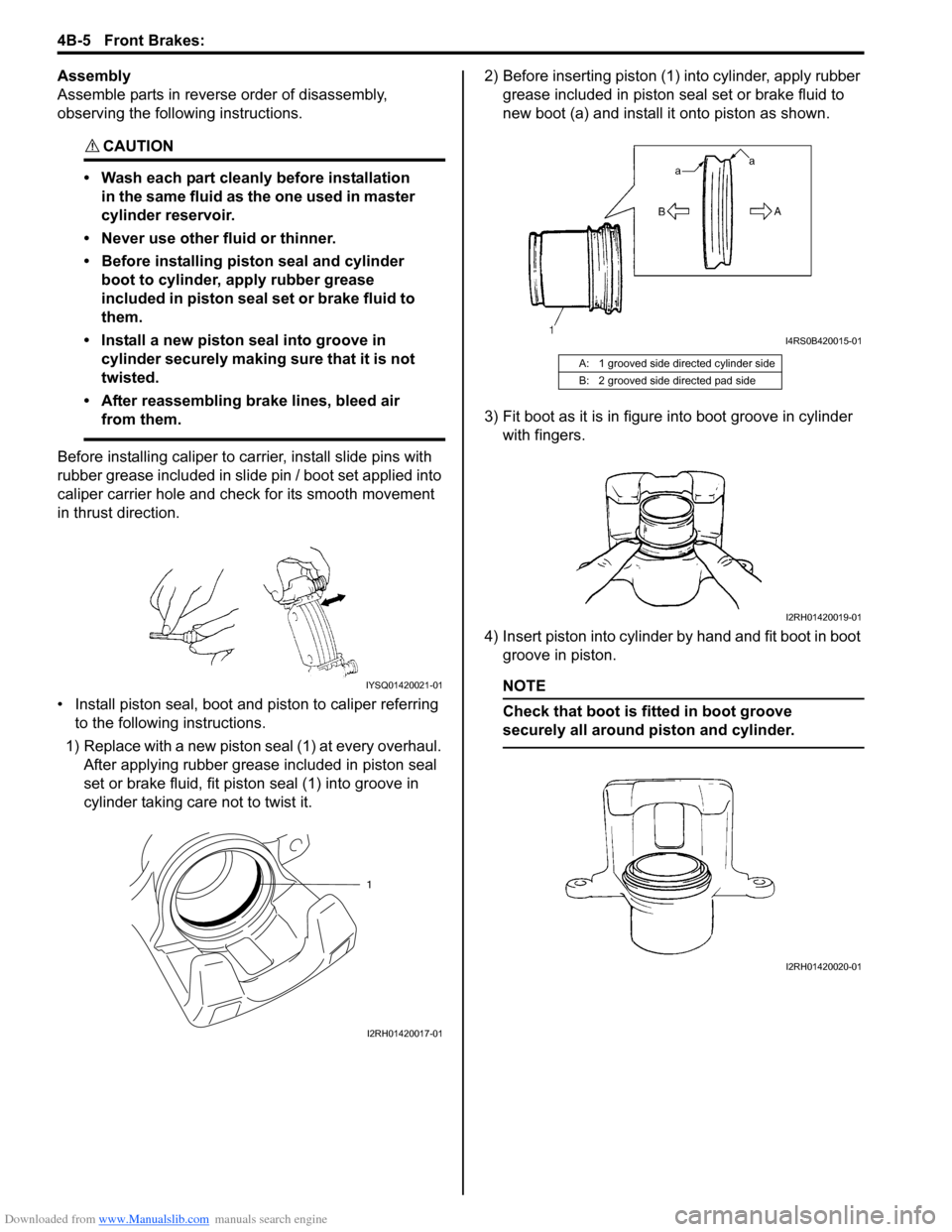
Downloaded from www.Manualslib.com manuals search engine 4B-5 Front Brakes:
Assembly
Assemble parts in reverse order of disassembly,
observing the following instructions.
CAUTION!
• Wash each part cleanly before installation
in the same fluid as the one used in master
cylinder reservoir.
• Never use other fluid or thinner.
• Before installing piston seal and cylinder
boot to cylinder, apply rubber grease
included in piston seal set or brake fluid to
them.
• Install a new piston seal into groove in
cylinder securely making sure that it is not
twisted.
• After reassembling brake lines, bleed air
from them.
Before installing caliper to carrier, install slide pins with
rubber grease included in slide pin / boot set applied into
caliper carrier hole and check for its smooth movement
in thrust direction.
• Install piston seal, boot and piston to caliper referring
to the following instructions.
1) Replace with a new piston seal (1) at every overhaul.
After applying rubber grease included in piston seal
set or brake fluid, fit piston seal (1) into groove in
cylinder taking care not to twist it.2) Before inserting piston (1) into cylinder, apply rubber
grease included in piston seal set or brake fluid to
new boot (a) and install it onto piston as shown.
3) Fit boot as it is in figure into boot groove in cylinder
with fingers.
4) Insert piston into cylinder by hand and fit boot in boot
groove in piston.
NOTE
Check that boot is fitted in boot groove
securely all around piston and cylinder.
IYSQ01420021-01
1
I2RH01420017-01
A: 1 grooved side directed cylinder side
B: 2 grooved side directed pad side
I4RS0B420015-01
I2RH01420019-01
I2RH01420020-01
Page 593 of 1556
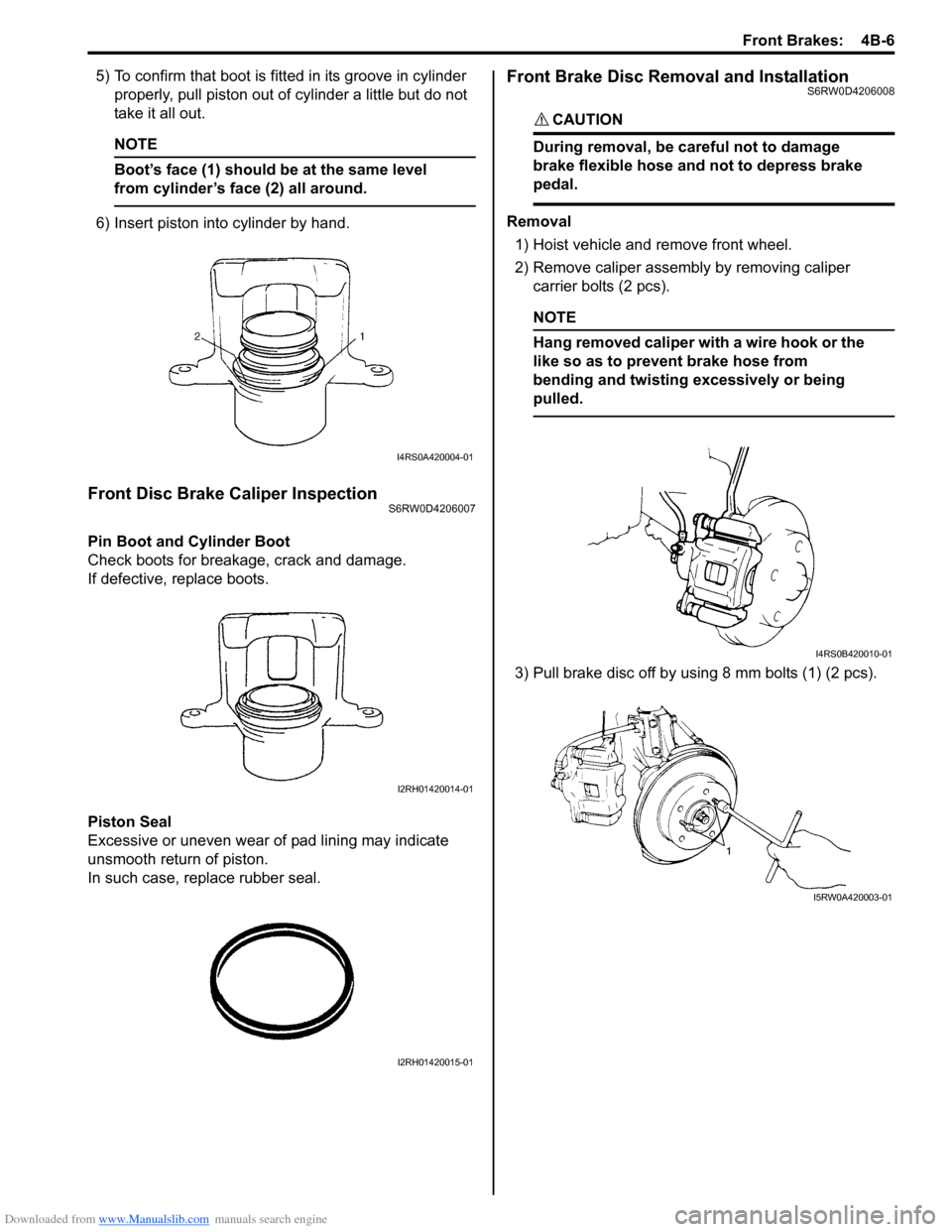
Downloaded from www.Manualslib.com manuals search engine Front Brakes: 4B-6
5) To confirm that boot is fitted in its groove in cylinder
properly, pull piston out of cylinder a little but do not
take it all out.
NOTE
Boot’s face (1) should be at the same level
from cylinder’s face (2) all around.
6) Insert piston into cylinder by hand.
Front Disc Brake Caliper InspectionS6RW0D4206007
Pin Boot and Cylinder Boot
Check boots for breakage, crack and damage.
If defective, replace boots.
Piston Seal
Excessive or uneven wear of pad lining may indicate
unsmooth return of piston.
In such case, replace rubber seal.
Front Brake Disc Removal and InstallationS6RW0D4206008
CAUTION!
During removal, be careful not to damage
brake flexible hose and not to depress brake
pedal.
Removal
1) Hoist vehicle and remove front wheel.
2) Remove caliper assembly by removing caliper
carrier bolts (2 pcs).
NOTE
Hang removed caliper with a wire hook or the
like so as to prevent brake hose from
bending and twisting excessively or being
pulled.
3) Pull brake disc off by using 8 mm bolts (1) (2 pcs).
I4RS0A420004-01
I2RH01420014-01
I2RH01420015-01
I4RS0B420010-01
I5RW0A420003-01
Page 596 of 1556
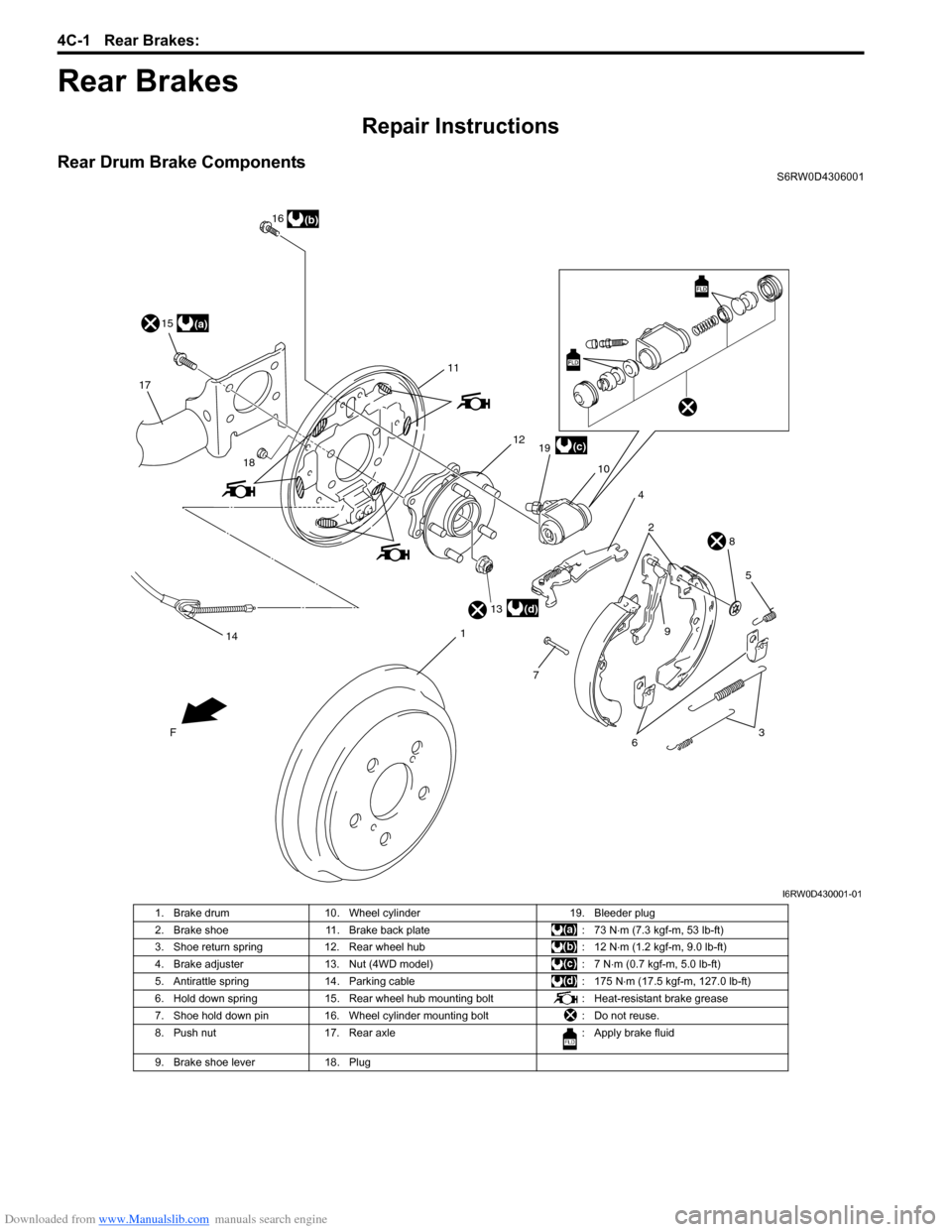
Downloaded from www.Manualslib.com manuals search engine 4C-1 Rear Brakes:
Brakes
Rear Brakes
Repair Instructions
Rear Drum Brake ComponentsS6RW0D4306001
11
2
3
4
5
6 7
12
1411310 16
19 15
17
98
18
F
(a)
(b)
(c)
(d)
I6RW0D430001-01
1. Brake drum 10. Wheel cylinder 19. Bleeder plug
2. Brake shoe 11. Brake back plate : 73 N⋅m (7.3 kgf-m, 53 lb-ft)
3. Shoe return spring 12. Rear wheel hub : 12 N⋅m (1.2 kgf-m, 9.0 lb-ft)
4. Brake adjuster 13. Nut (4WD model) : 7 N⋅m (0.7 kgf-m, 5.0 lb-ft)
5. Antirattle spring 14. Parking cable : 175 N⋅m (17.5 kgf-m, 127.0 lb-ft)
6. Hold down spring 15. Rear wheel hub mounting bolt : Heat-resistant brake grease
7. Shoe hold down pin 16. Wheel cylinder mounting bolt : Do not reuse.
8. Push nut 17. Rear axle : Apply brake fluid
9. Brake shoe lever 18. Plug
Page 598 of 1556
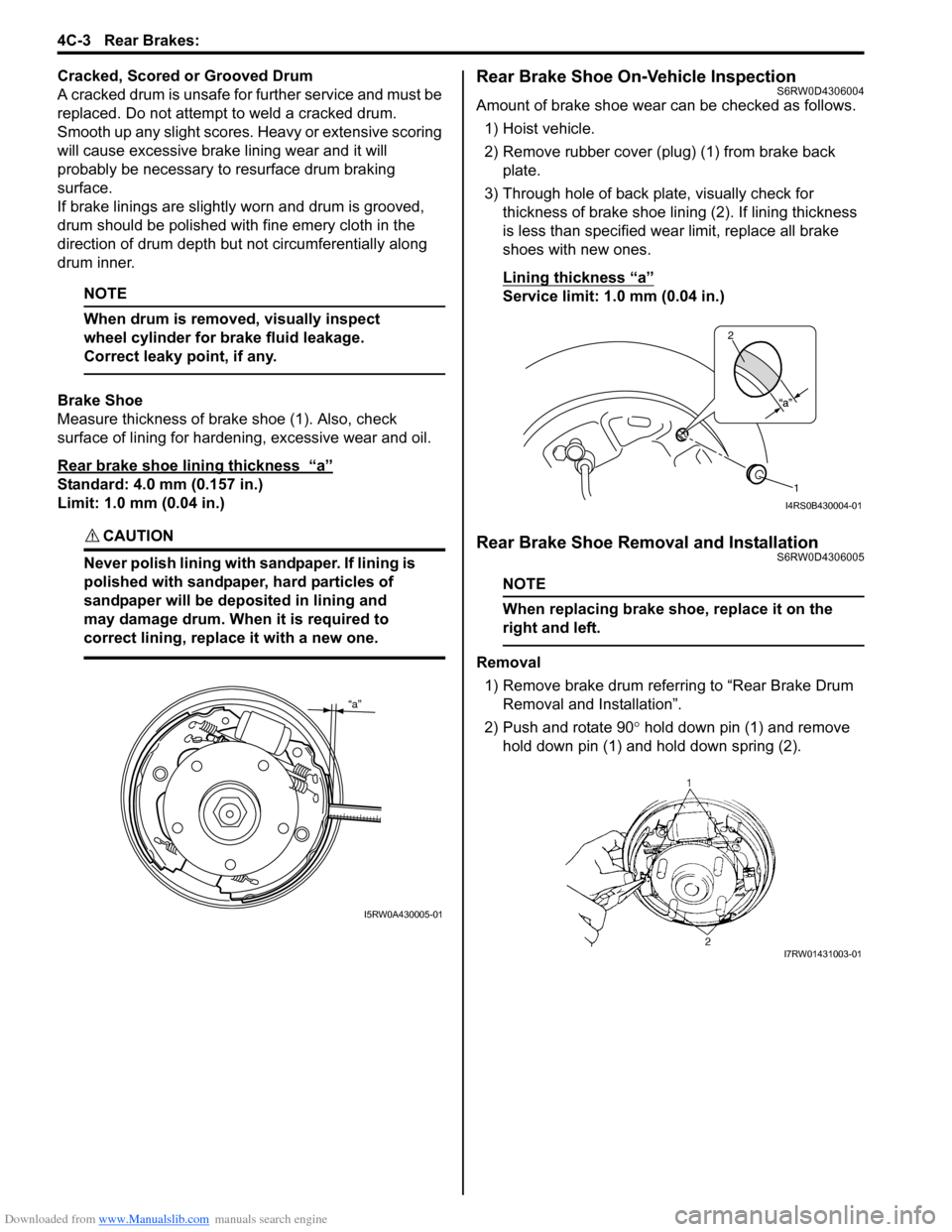
Downloaded from www.Manualslib.com manuals search engine 4C-3 Rear Brakes:
Cracked, Scored or Grooved Drum
A cracked drum is unsafe for further service and must be
replaced. Do not attempt to weld a cracked drum.
Smooth up any slight scores. Heavy or extensive scoring
will cause excessive brake lining wear and it will
probably be necessary to resurface drum braking
surface.
If brake linings are slightly worn and drum is grooved,
drum should be polished with fine emery cloth in the
direction of drum depth but not circumferentially along
drum inner.
NOTE
When drum is removed, visually inspect
wheel cylinder for brake fluid leakage.
Correct leaky point, if any.
Brake Shoe
Measure thickness of brake shoe (1). Also, check
surface of lining for hardening, excessive wear and oil.
Rear brake shoe lining thickness
“a”
Standard: 4.0 mm (0.157 in.)
Limit: 1.0 mm (0.04 in.)
CAUTION!
Never polish lining with sandpaper. If lining is
polished with sandpaper, hard particles of
sandpaper will be deposited in lining and
may damage drum. When it is required to
correct lining, replace it with a new one.
Rear Brake Shoe On-Vehicle InspectionS6RW0D4306004
Amount of brake shoe wear can be checked as follows.
1) Hoist vehicle.
2) Remove rubber cover (plug) (1) from brake back
plate.
3) Through hole of back plate, visually check for
thickness of brake shoe lining (2). If lining thickness
is less than specified wear limit, replace all brake
shoes with new ones.
Lining thickness “a”
Service limit: 1.0 mm (0.04 in.)
Rear Brake Shoe Removal and InstallationS6RW0D4306005
NOTE
When replacing brake shoe, replace it on the
right and left.
Removal
1) Remove brake drum referring to “Rear Brake Drum
Removal and Installation”.
2) Push and rotate 90° hold down pin (1) and remove
hold down pin (1) and hold down spring (2).
“a”
I5RW0A430005-01
2
1
I4RS0B430004-01
I7RW01431003-01